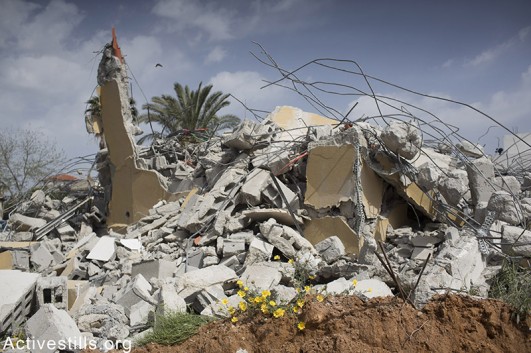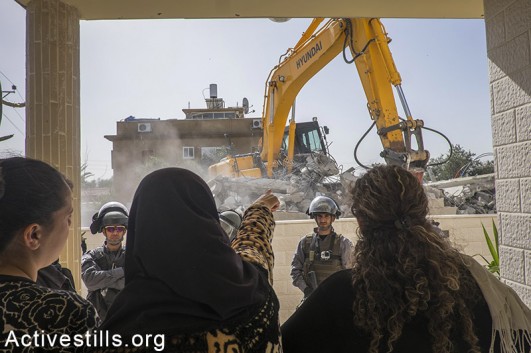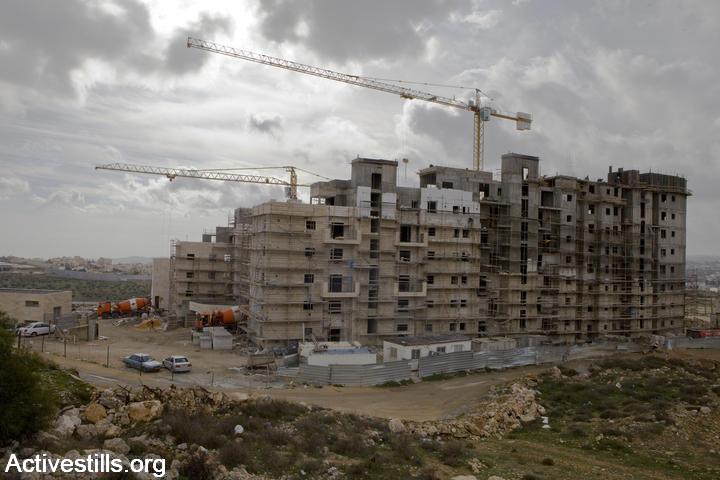Israel’s housing system is not ‘failing’ its Palestinian citizens. It is working exactly as it was intended: to minimize Arab lands in order to maximize Jewish communities.

Half an hour north of Tel Aviv stand several hills offering a natural panoramic view of the bustling Arab towns of Taibeh and Tira, their congested neighborhoods, and their narrow roads and alleys. Surrounding the towns are the smaller and orderly Jewish villages and farming communities of Sha’ar Efraim, Sde Warburg, Ramat Hakovesh, and others. The hilltops used to be empty; now they are home to high-rise apartments of the new Jewish town of Tzur Yitzhak, along with Tzur Natan, Kokhav Yair and Tzur Yigal.
The view from those hills encapsulates Israel’s land policy toward the Palestinian communities in the state that survived after 1948. Although Taibeh and Tira are among the largest localities in the area (about 40,000 and 24,000 residents respectively), they are physically constrained by the sparse Jewish communities around them, whose populations are at most in the few hundreds or thousands. Many of the surrounding lands once belonged to Palestinians but were transferred to Jewish owners during the state’s formative years. The roads and highways around Taibeh and Tira further serve as barriers that prevent the towns from expanding.
This man-made landscape is not only the result of decades-old policies – it is an active process that continues to this day. Just last week, Israeli authorities demolished a home near Taibeh that belonged to a family of 11, which was built without a construction permit on land that was zoned for agricultural use. The Israeli tractors were accompanied by masked police forces that used stun grenades and “skunk” water to disperse and arrest protesting residents.
The following day, Haaretz reported that the attorney general approved recommendations to “increase enforcement of planning and construction laws,” which includes carrying out demolitions against illegal buildings and issuing fines against their inhabitants. Members of the Palestinian leadership in Israel connected these developments to Netanyahu’s call to enhance law enforcement in the Palestinian sector, a message he championed after last month’s shooting in Tel Aviv. The new plan amounts to harassment of the Palestinian community, the Palestinian leadership maintains.

Israeli authorities claim the demolitions are about applying the rule of law, saying that thousands of Palestinian citizens are refusing to follow planning procedures and abide by their local and regional master plans. What they do not mention is that those procedures and plans systemically ignore Palestinian citizens’ needs.
Out of over 40,000 construction tenders for new housing units published by the Israel Land Authority in 2014, only 1,844 units (4.6 percent) were in Palestinian towns. Out of 139 Palestinian localities included in Israel’s new national master plan, only 41 of them (29.4 percent) have been given updated plans. Palestinian couples still find that it can take years to acquire a building permit, making it difficult to secure a home by the time they start their new lives.
The state is well aware of the difficult circumstances faced by Palestinian citizens – because it deliberately created them. Combining land confiscations, bureaucratic intransigence, racist laws, and home demolitions, the state has fulfilled its goal of minimizing Arab lands for the purpose of maximizing Jewish lands.
Palestinian citizens make up 20 percent of Israel’s population, but their localities constitute only 3 to 3.5 percent of the state’s territory. No new Arab town has been built since Israel’s establishment, with the exception of seven impoverished townships that were created to concentrate half of the Naqab’s Bedouin citizens and dispossess them of their historic lands. In contrast, hundreds of urban and rural Jewish towns have rapidly proliferated and immediately received basic services – including settlements in the occupied territories.
The discrimination runs even deeper. Over 430 small Jewish towns in the North and South use admissions committees to bar Palestinian citizens from living among them, claiming they are “socially and culturally unsuitable” for the communities. Government funding for the Arab sector remains extremely unequal despite repeated plans to close economic gaps, which exacerbates Arab towns’ poor infrastructure. More alarmingly, dozens of unrecognized Bedouin villages in the Naqab like Umm al-Hiran, which the state has refused to grant legal status for decades, are slated to be destroyed in order to build new towns and farms exclusively for Jewish citizens.
Caught in legal limbo, it is unsurprising that thousands of Palestinian families choose to build their homes illegally and outside their towns’ designated spaces. For the state, the catch-22 plays entirely in its favor. It forces and intimidates the majority of Palestinian citizens to remain within the confines of their own communities, while creating an excuse to punish those who dare to bypass its discriminatory institutions. Targeted demolitions like last week’s near Taibeh – just like home demolitions in the Naqab, East Jerusalem, and the West Bank – are then used to set examples to the Palestinian community, ordering them to stay behind their demarcated spaces.
The problem, therefore, is not that Israel’s housing system is “failing” its Palestinian citizens. The system is working exactly as it was intended. Tzur Yitzhak, one of the Jewish communities on the hilltops between Taibeh and Tira, was only established in 2007 and already has nearly 3,500 residents in its towering apartments. The houses of Taibeh and Tira, meanwhile, remain exactly where they were a decade ago, kept at bay by the roads and gated communities. That same view can be found in countless spots across the country, revealing the scale to which Israel has worked to keep its Arabs separate from its Jews.



